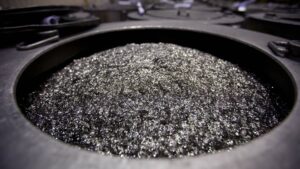Title: Decoding the Future of Rare Earths: How the West is Navigating Supply Chain Challenges
As the global automotive landscape shifts towards electric vehicles (EVs), the crucial role of rare earth minerals has never been more pronounced. Notably, the ongoing dominance of China in this sector has raised significant alarms in the West, prompting a concerted effort to reduce dependency and innovate sustainable solutions.
Understanding the Rare Earth Landscape
Recent analyses highlight that China commands a staggering 69% of global rare earth mine production and holds nearly half of the world’s reserves. This uneven distribution has made it essential for countries like the U.S. to seek alternative sources and technologies. In September 2024, for instance, the U.S. Department of Defense made a strategic move by investing $4.2 million in Rare Earth Salts, a startup dedicated to extracting rare earth oxides from domestic waste products like old fluorescent bulbs.
Moreover, with over 550 grams of rare earth components required for a typical electric vehicle—compared to just 140 grams in gasoline-powered cars—the need for reliable supply chains is paramount. According to the consulting firm AlixPartners, the reliance on these elements will only grow as EV adoption increases globally.
Recycling: A Hidden Goldmine
At Extreme Investor Network, we see recycling as a significant trend that will shape the future of rare earth procurement. As the first generation of EVs approaches the end of their life cycle, these vehicles will not only be recycled, providing a domestic source of critical minerals, but will also lead to a reduction in reliance on Chinese materials. This emerging movement towards recycling is not merely about conserving resources; it represents a radical shift in supply chain dynamics.
Christopher Ecclestone, a principal strategist at Hallgarten & Company, anticipates that “pretty soon, the first generation of EVs will be up for recycling themselves, creating a pool of ex-China material that will be under the control of the West.” This perspective reinforces the notion that sustainability and strategic mineral recovery go hand-in-hand.
The Push for Innovation
Multinational corporations are also investing significantly in technology designed to minimize reliance on rare earth elements. Companies like Toyota are pioneering efforts to innovate battery technology, reducing the amount of rare earths required. Simultaneously, the automotive market in the U.S. saw a modest increase in electric vehicle sales, rising to 7.5% in the first quarter of 2024. However, the challenge remains: the vast majority of components are still sourced internationally, primarily from China.
Bridging the Gap: Challenges Ahead
Despite these advancements, the pathway to alternative sourcing isn’t without challenges. Mines take years to secure operating approval, and establishing processing plants requires not only time but also significant expertise. Currently, China controls about 90% of the global refined supply of key minerals like neodymium, praseodymium, dysprosium, and terbium—all of which are instrumental in manufacturing high-performance magnets for EV motors.
In April 2024, China’s announcement of export controls on crucial rare earths, specifically targeting terbium, sent shockwaves through international markets. The repercussions of this strategic maneuver could amplify the existing trade tensions between China and the U.S., distorting markets further.
Diversifying the Supply Chain
The future landscape of automotive manufacturing and national defense hinges on diversifying supply chains away from China. For instance, tungsten, not typically viewed as a rare earth but categorized as a critical mineral, is vital for both military applications and automotive batteries. China’s share of tungsten production complicates matters even further, with projections indicating that 50% of global tungsten demand is fulfilled by Chinese sources.
This critical dependency underscores the need for the West to ramp up local production capabilities. Companies looking to invest in new mines outside China should be encouraged, considering the potential market growth and the strategic importance of these metals.
Conclusion: Sustainable Growth and Investment Opportunities
Navigating the rare earth landscape requires a multifaceted approach that balances immediate needs with long-term sustainability. As businesses and governments explore innovative mining and recycling processes, exciting investment opportunities will undoubtedly arise.
At Extreme Investor Network, we believe that understanding these dynamics is essential for anyone looking to invest in the future of technology and sustainability. The emerging landscape is not just about combating supply chain fears; it’s about seizing the opportunity to build a more resilient and self-sufficient economy.
For continuous insights and strategic investment tips, subscribe to our newsletter and stay ahead of the curve in the ever-evolving world of finance and investment.

